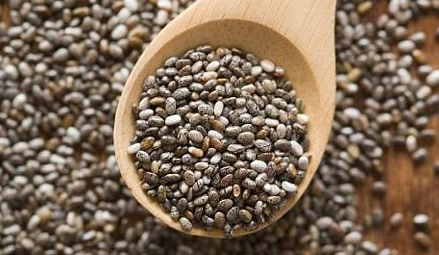Chia is an edible seed that comes from the desert plant Salvia hispanica, grown in Mexico dating back to Mayan and Aztec cultures. “Chia” means strength, and folklore has it that these cultures used the tiny black and white seeds as an energy booster. That makes sense, as chia seeds are a concentrated food containing healthy omega-3 fatty acids, carbohydrates, protein, fiber, antioxidants, and calcium.
- Chia seeds are an unprocessed, whole-grain food that can be absorbed by the body as seeds (unlike flaxseeds). One ounce (about 2 tablespoons) contains 139 calories, 4 grams of protein, 9 grams fat, 12 grams carbohydrates and 11 grams of fiber, plus vitamins and minerals.
How to eat Chia Seeds:
- Chia seeds can be eaten raw or prepared in a number of dishes. Sprinkle ground or whole chia seeds on cereal, rice, yogurt or vegetables. Chia seeds are very absorbent and develop a gelatinous texture when soaked in water making it easy to mix them into cooked cereal or other dishes.
- The seeds are not the only important part of the chia plant; the sprouts are also edible. Try adding them to salads, sandwiches and other dishes.
- The mild, nutty flavor of chia seeds makes them easy to add to foods and beverages. They are most often sprinkled on cereal, sauces, vegetables, rice dishes, or yogurt or mixed into drinks and baked goods. They can also be mixed with water and made into a gel.
Benefits
- Omega-3 fatty acids: Chia seeds are rich in polyunsaturated fats, especially omega-3 fatty acids. Chia seeds’ lipid profile is composed of 60 percent omega-3s, making them one of the richest plant-based sources of these fatty acids — specifically, of alpha-linolenic acid, or ALA. The omega-3s in chia seeds can help reduce inflammation, enhance cognitive performance and reduce high cholesterol.
- Fiber: Chia seeds are an excellent source of fiber, with a whopping 10 grams in only 2 tablespoons. That is one-third of the daily recommended intake of fiber per day. Fiber is associated with reducing inflammation, lowering cholesterol and regulating bowel function.
- Antioxidants: Chia seeds are rich in antioxidants that help protect the body from free radicals, aging and cancer. The high antioxidant profile also helps them have a long shelf life, they can last almost two years without refrigeration.
- Minerals: Two tablespoons of chia seeds contain 18 percent of the DRI for calcium, 35 percent for phosphorus, 24 percent for magnesium and about 50 percent for manganese. These nutrients help you prevent hypertension and maintain a healthy weight, and are important for energy metabolism and a part of DNA synthesis.
- Satiety: Satiety is the feeling of being full and satisfied, which helps lower food cravings between meals. The combination of protein, fiber and the gelling action of chia seeds when mixed with liquids all contribute to their satiating effects.
- Gluten-Free: Chia seeds contain no gluten or grains. Therefore, all of the nutritional benefits of chia seeds can be obtained on a gluten-free diet.
- Egg Replacer: The outer layer of chia seeds swells when mixed with liquids to form a gel. This can used in place of eggs to lower cholesterol and increase the nutrient content of foods and baked goods. To make the egg replacement, mix 1 tablespoon of chia seeds with 3 tablespoons of water and let sit for 15 minutes.
- Can be Digested Whole: Unlike flaxseeds, which are also high in omega-3 fatty acids, fiber and minerals, chia seeds do not need to be ground in order to obtain their nutrient or egg-replacement benefits.
- Dyslipidemia: A study published in the “British Journal of Nutrition” showed that chia seeds as a dietary fat source can lower triglycerides and cholesterol levels while increasing HDL or “good” cholesterol. The study also found that when substituting chia seeds for other fat sources, such as corn oil, the ALA was able to prevent high triglyceride levels and reduce central obesity.
- Blood Sugar Regulation: Chia seeds can play an important role in regulating insulin levels. They can reduce insulin resistance and decrease abnormally high levels of insulin in the blood.
References
- Source: Gunnars, Kris, “11 Proven Health Benefits of Chia Seeds (No. 3 is Best)”, web article-Authority Nutrition, www.authoritynutrition.com/11-proven-health-benefits-of-chia-seeds/

